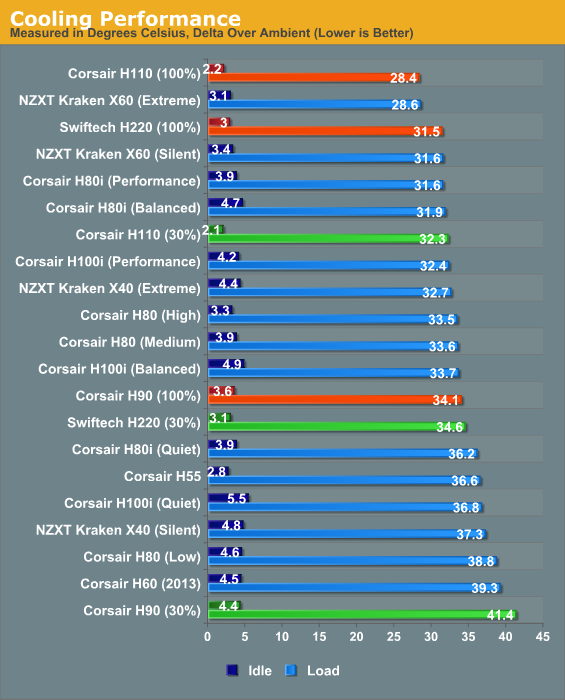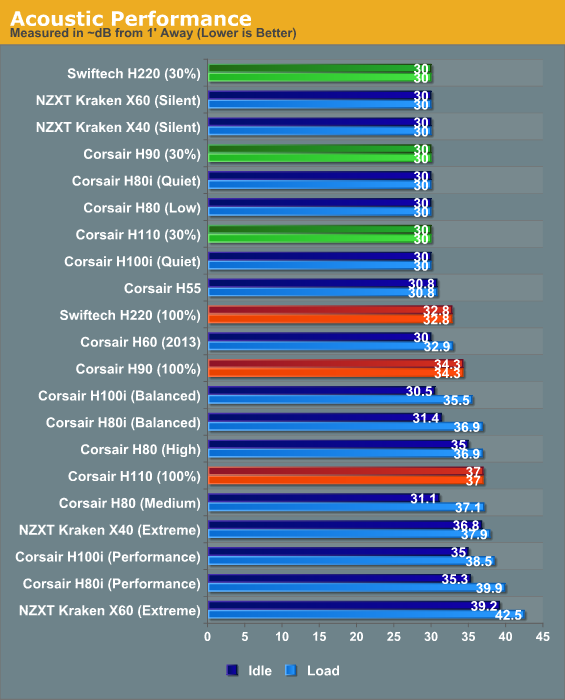Closing the Loop II: New Liquid Coolers from Corsair and Swiftech
by Dustin Sklavos on February 1, 2013 12:01 AM EST- Posted in
- Cases/Cooling/PSUs
- Corsair
- radiator
- Swiftech
Performance Results
I mentioned in the introduction that the new Corsair radiators are operating off of the same OEM hardware as NZXT's resident 140mm-based radiators. What I didn't mention was that Corsair doesn't have any software control for the fans or even any allowances made towards connecting and controlling the fans at all beyond the conventional motherboard headers. Corsair needs to hope the fans used on their H90 and H110 are enough to differentiate them from NZXT's Kraken series.
Swiftech, meanwhile, also uses PWM control, but includes a breakout block with the H220 to connect as many as seven different fans to a single PWM channel. It's worth noting, too, that though the Swiftech H220 is a 240mm radiator (like the Corsair H100i), the building materials and pump are almost completely different. The pump uses Swiftech's own secret sauce, while the radiator uses brass and copper instead of the garden variety aluminum the other radiators use. On top of this, they're using their own fans. Suffice to say, it's going to be interesting to see if the H220 can prove the extra effort and higher quality components are worthwhile.

Whether it's Corsair, NZXT, or good old-fashioned Asetek, the results don't lie: the 280mm radiator is just plain more efficient than any smaller block. Swiftech's H220 puts in a reasonably strong showing, though interestingly it has trouble overtaking the Corsair H80i at higher speeds. There's a very good reason for that, though, and you'll see it in a second.
Meanwhile, Asetek's single 140mm radiator basically continues to be a bust. It's by no means a terrible product, but the H90 and Kraken X40 are both pretty underwhelming. A thicker 120mm radiator with two fans continues to be a comparable if not superior choice.

If the Swiftech H220's performance is a little underwhelming, this is why. The H220 itself is definitely a strong radiator, but Swiftech clearly tuned their fans for acoustics instead of performance. At 30% fan speed only the X60 and H110 can offer both better thermal performance and fan speed, but at 100% fan speed, the louder, more aggressive fans are just able to push more cool air through their respective radiators.
What must be kept in mind is that while the H220 isn't necessarily blowing up the charts, the noise levels and thermal performance need to be connected and placed in context. The H220 is able to deliver competitive performance at lower noise levels than the competing radiators, and really only has to worry about the Corsair H110 and Kraken X60 beating it. Both of those are much harder to fit into most cases, too, a problem the Swiftech H220 doesn't have.










53 Comments
View All Comments
glenster - Friday, February 1, 2013 - link
The Thermaltake Water 2.0 Extreme is 27dB--how does it compare?Beenthere - Friday, February 1, 2013 - link
Before long they will be using auto sized radiators to try and surpass the excellent and reliable cooling provided by a highend HSF costing 1/2 the price of an inferior closed loop coolers that can and have leaked in the past causing hundreds of dollars in PC hardware damage, lost data, lack of use of the PC for weeks, RMAs, etc. Why people are so gullible as to buy an inferior CPU cooling system is beyond me. I guess when you're technically challenged, you equate water to better cooling even when it's not.Stuka87 - Friday, February 1, 2013 - link
"Meanwhile, the radiator itself has a larger reservoir than the competition, is user accessible and serviceable, and is produced from higher quality materials. Instead of just using aluminum, the H220 has copper fins and brass tubing, which theoretically will allow it to both dissipate heat more effectively and last longer. "In the quote above, it is stated that the H220 uses copper and brass instead of aluminum. While copper is great as its the best conductor of heat, brass is significantly worse than copper or aluminum. Kind of seams like a price cutting tactic over the use of aluminum and copper. Unless I am missing something?
Death666Angel - Friday, February 1, 2013 - link
My guess would be corrosion.Galcobar - Friday, February 1, 2013 - link
Galvanic corrosion -- two dissimilar metals in contact are a problem, particularly with something reactive such as copper. It's why you can't use steel brackets to hold copper piping.Copper and brass (a copper-zinc alloy) are electrochemically similar so galvanic corrosion isn't an issue. Aluminum, however, is much more anodic than copper or brass.
Nickel020 - Monday, February 11, 2013 - link
Brass is what's used in almost all high-end watercooling radiators, Swiftech isn't cutting any corners there. The fins themselves are actually copper, and that's what's most important. There's also different kinds of brass, and the one they're using for the tubing is almost certainly better than aluminum. Otherwise you'd find high-end watercooling radiators made with aluminum tubing, but they all use brass or (a few) copper.Gc - Friday, February 1, 2013 - link
The Cinica Eurora article says they claim increased power efficiency in part by running the processors at lower water-cooled temperatures. It could be interesting to see how much power each water-cooling system takes, both for comparing with air-cooled systems, and for comparing with potential processor power savings.Gc - Friday, February 1, 2013 - link
[Sorry, "air-cooled" is the wrong term for the contrast. These water-cooling systems carry the heat to an air cooled radiator also, just like the vapor cooled heat pipes in many CPU coolers carry heat to an air cooled radiator.]RaistlinZ - Friday, February 1, 2013 - link
Can fans be mounted on the Swiftech for push/pull config? If so, they've got my money.Dustin Sklavos - Saturday, February 2, 2013 - link
Why yes. YES THEY CAN! And in fact their fan control header supports up to seven fans!